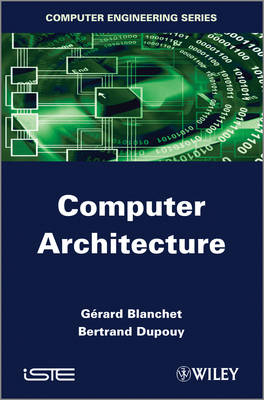
Computer Architecture
ISTE Ltd and John Wiley & Sons Inc (Verlag)
978-1-84821-429-3 (ISBN)
This book lays out the concepts necessary to understand how a computer works.
For reasons of clarity, the authors have deliberately chosen examples that apply to machines from all eras, without having to water down the contents of the book. This choice helps to show how techniques, concepts and performances have evolved since the first computers.
The book is divided into five parts. The first four, which are of increasing difficulty, are the core of the book: “Elements of a Basic Architecture”, “Programming Model and Operation”, “Memory Hierarchy”, “Parallelism and Performance Enhancement”. The final part provides hints and solutions to the exercises in the book as well as appendices. The reader may approach each part independently based on their prior knowledge and goals.
Gérard Blanchet is the author of Computer Architecture, published by Wiley. Bertrand Dupouy is the author of Computer Architecture, published by Wiley.
Preface xiii
Part 1. Elements of a Basic Architecture 1
Chapter 1. Introduction 3
1.1. Historical background 3
1.2. Introduction to internal operation 13
1.3. Future prospects 15
Chapter 2. The Basic Module 17
2.1. Memory 17
2.2. The processor 20
2.3. Communication between modules 30
Chapter 3. The Representation of Information 35
3.1 Review 36
3.2. Number representation conventions 38
3.3. Character representation 48
3.4 Exercises 52
Part 2. Programming Model and Operations 55
Chapter 4. Instructions 57
4.1. Programming model 58
4.2 The set of instructions 62
4.3. Programming examples 68
4.4. From assembly language to basic instructions 70
Chapter 5. The Processor 74
5.1. The control bus 76
5.2. Execution of the instruction 79
5.3. Sequencer composition 87
5.4. Extensions 91
5.5. Exercise 101
Chapter 6. Inputs and Outputs 103
6.1. Examples 105
6.2. Design and addressing of EU 115
6.3. Exchange modes 118
6.4. Handling interrupts 127
6.5. Exercises 133
Part 3. Memory Hierarchy 137
Chapter 7. Memory 139
7.1. The memory resource 139
7.2. Characteristics 140
7.3. Memory hierarchy 141
7.4. Memory size and protection 145
7.5. Segmentation 145
7.6. Paging 148
7.7. Memory interleaving and burst mode 151
7.8. Protections, example of the I386 154
Chapter 8. Caches 157
8.1. Cache memory 157
8.2. Replacements algorithms 165
Chapter 9. Virtual Memory 175
9.1. General concept 176
9.2. Rules of the access method 178
9.3 Example of the execution of a program 182
9.4. Example of two-level paging 188
9.5 Paged segmentation 194
9.6. Exercise 197
9.7. Documentation excerpts 198
Part 4. Parallelism and Performance Enhancement 205
Chapter 10. Pipeline Architectures 207
10.1 Motivations and Ideas 207
10.2 Pipeline management problems 212
10.3 Handling branches 218
10.4 Interrupts and exceptions 233
Chapter 11. Example of an Architecture 235
11.1 Presentation 235
11.2. Executing an instruction 240
11.3. Conflict resolution in the DLX 246
11.4. Exercises 252
Chapter 12. Caches in a Multiprocessor Environment 261
12.1. Cache coherence 262
12.2. Examples of snooping protocols 267
12.3. Improvements 275
12.4. Directory-based coherence protocols 275
12.5. Consistency 278
12.6. Exercises 284
Chapter 13. Superscaler Architectures 287
13.1. Superscaler architecture principles 287
13.2. Seeking solutions 290
13.3. Handling the flow of instructions 295
13.4. VLIW architectures 315
13.5. Exercises 321
Part 5. Appendices 325
Appendix A. Hints and Solutions 327
A1.1 The representation of information 327
A1.2. The processor 330
A1.3. Inputs and outputs 331
A1.4. Virtual memory 333
A1.5. Pipeline architectures 335
A1.6. Caches in a multiprocessor environment 341
A1.7. Superscaler architectures 344
Appendix B. Programming Models 347
A2.1. Instruction coding in the I8086 347
A2.2. Instruction set of the DLX architecture 349
Bibliography 351
Index 357
| Verlagsort | London |
|---|---|
| Sprache | englisch |
| Maße | 161 x 240 mm |
| Gewicht | 708 g |
| Themenwelt | Mathematik / Informatik ► Informatik ► Theorie / Studium |
| ISBN-10 | 1-84821-429-4 / 1848214294 |
| ISBN-13 | 978-1-84821-429-3 / 9781848214293 |
| Zustand | Neuware |
| Informationen gemäß Produktsicherheitsverordnung (GPSR) | |
| Haben Sie eine Frage zum Produkt? |
aus dem Bereich


